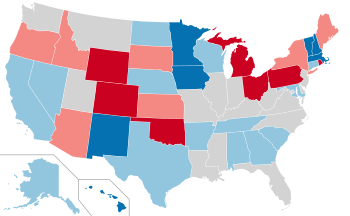
The 1974 United States Senate elections were held in the wake of the Watergate scandal, Richard M. Nixon's resignation from the presidency, and Gerald Ford's subsequent pardon of Nixon. Economic issues, specifically inflation and stagnation, were also a factor that contributed to Republican losses. As an immediate result of the November 1974 elections, Democrats made a net gain of three seats from the Republicans, as they defeated Republican incumbents in Colorado and Kentucky and picked up open seats in Florida and Vermont, while Republicans won the open seat in Nevada. Following the elections, at the beginning of the 94th U.S. Congress, the Democratic caucus controlled 61 seats, and the Republican caucus controlled 38 seats.

The 1970 United States Senate elections was an election for the United States Senate, taking place in the middle of Richard Nixon's first term as president. The Democrats lost a net of three seats, while the Republicans and the Conservative Party of New York picked up one net seat each, and former Democrat Harry F. Byrd Jr. was re-elected as an independent.

The 1968 United States Senate elections were elections for the United States Senate which coincided with the presidential election of the same year. Although Richard Nixon won the presidential election narrowly, the Republicans picked up five net seats in the Senate. This saw Republicans win a Senate seat in Florida for the first time since Reconstruction.

The 1964 United States Senate elections coincided with the election of President Lyndon B. Johnson by an overwhelming majority, to a full term. His Democratic Party picked up a net two seats from the Republicans. As of 2022, this was the last time either party has had a two-thirds majority in the Senate, which would have hypothetically allowed the Senate Democrats to override a veto, propose constitutional amendments, convict and expel certain officials, or invoke cloture without any votes from Senate Republicans. In practice, however, internal divisions effectively prevented the Democrats from doing so. The Senate election coincided with Democratic gains in the House in the same year.

The 1962 United States Senate elections was an election for the United States Senate which was held in the middle of President John F. Kennedy's term. His Democratic Party made a net gain of four seats from the Republicans, increasing their control of the Senate to 68-32. However, this was reduced to 67-33 between the election and the next Congress, as on November 18, 1962, Democrat Dennis Chávez, who was not up for election that year, died. He was replaced on November 30, 1962, by Republican appointee Edwin L. Mechem. This was the first time since 1932 that Democrats gained seats in this class of Senators.

The 1960 United States Senate elections coincided with the election of John F. Kennedy as president on November 8, 1960. A special election was held on June 28, 1960, for a mid-term vacancy in North Dakota. The Republicans gained two seats at the expense of the Democrats. However, Republican Senator-elect Edwin Keith Thomson of Wyoming died December 9, 1960, and was replaced by appointee Democratic John J. Hickey at the beginning of the Congress, reducing Republican gains to one seat.

The 1958 United States Senate elections were elections for the United States Senate which occurred in the middle of President Dwight D. Eisenhower's second term.
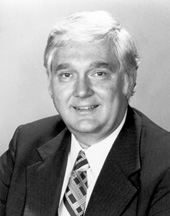
Mark Andrews was an American politician from the state of North Dakota. He was a member of the Republican Party and served as a U.S. senator.
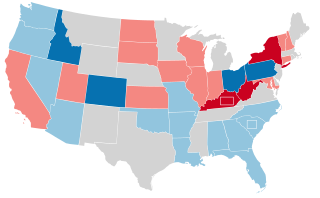
The 1956 United States Senate elections were elections for the United States Senate that coincided with the re-election of President Dwight D. Eisenhower. Although Democrats gained two seats in regular elections, the Republicans gained two seats in special elections, leaving the party balance of the chamber unchanged.

The 1936 United States Senate elections coincided with the reelection of President Franklin D. Roosevelt. The Great Depression continued and voters backed progressive candidates favoring Roosevelt's New Deal in races across the country. The Democrats gained 5 net seats during the election, and in combination with Democratic and Farmer–Labor interim appointments and the defection of George W. Norris from the Republican Party to become independent, the Republicans were reduced to 16 seats, the most lopsided Senate since Reconstruction.

Quentin Northrup Burdick was an American lawyer and politician. A member of the North Dakota Democratic-NPL Party, he represented North Dakota in the U.S. House of Representatives (1959–1960) and the U.S. Senate (1960–1992). At the time of his death, he was the third longest-serving senator among current members of the Senate.

In the 1912–13 United States Senate elections, Democrats gained control of the Senate from the Republicans. Of the 32 seats up for election, 17 were won by Democrats, thereby gaining 4 seats from the Republicans. Two seats were unfilled by state legislators who failed to elect a new senator on time. They were the last Senate elections held before ratification of the 17th Amendment, which established direct elections for all seats in the Senate.
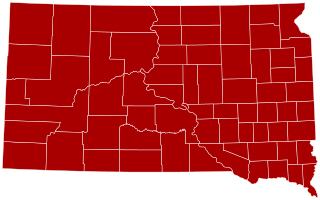
The 2010 United States Senate election in South Dakota was held on November 2, 2010 along other elections to the United States Senate in other states as well as elections to the United States House of Representatives and various state and local elections. Incumbent Republican U.S. Senator John Thune won re-election to a second term unopposed.

The 1896–97 United States Senate elections were elections in which the Democratic Party lost seven seats in the United States Senate, mostly to smaller third parties.

The 1794–95 United States Senate elections were elections that had the formation of organized political parties in the United States, with the Federalist Party emerging from the Pro Administration coalition, and the Democratic-Republican Party emerging from the Anti-Administration coalition.

United States gubernatorial elections were held on 8 November 1960, in 27 states concurrent with the House, Senate elections and presidential election.

United States gubernatorial elections were held in 1958, in 34 states, concurrent with the House and Senate elections, on November 4, 1958. Alaska held its first gubernatorial election on achieving statehood.

United States gubernatorial elections were held in 1894, in 28 states, concurrent with the House and Senate elections, on November 6, 1894.

United States gubernatorial elections were held in 1892, in 32 states, concurrent with the House, Senate elections and presidential election, on November 8, 1892.
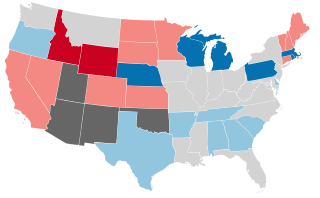
United States gubernatorial elections were held in 1890, in 27 states, concurrent with the House and Senate elections, on November 4, 1890.
